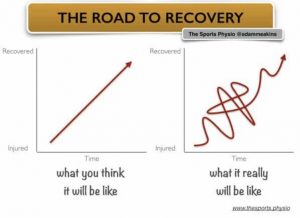How to Stretch Out a Thrown Out Back
Most of us have experienced that sudden unexpected sharp low back pain and the inability to fully stand up erect afterward. If you haven't yet, chances are you likely will at some point. Unfortunately, we oftentimes do not expect it to happen as it either occurs with the most obscure unthreatening activities (picking up a pencil, wresting with your kids, getting out of the car, etc.) or when we believe we are physically prepared to take on load (deadlifting, squatting, etc.) but the aftermath tells us otherwise. So, when it happens, what should you do?
First, don't panic. Take a moment to catch your breath and evaluate the situation. Yes, it can be extremely painful and alarming but 99.999% of the time it isn't life threatening. To assist ruling out more severe pathology (cancer, spinal cord injury, etc.), think about the how the pain started and the resulting symptoms. Below are some criteria to help:
- Is the pain associated with a low-traumatic specific cause or mechanism (picking something up, twisting, etc.)?
- Does the pain change with movement and/or position (ex: worsens with bending, better with sitting, better with walking, worse in the morning, etc.)?
- Are you experiencing any other concerning symptoms (ex: changes in bowel/bladder function, nausea/vomiting, numbness/tingling, unexplained weight fluctuations, paralysis or severe sudden weakness, dizziness, headaches, etc.)?
If you can answer "yes" to the first two questions and "no" to the third, then the pain is likely "mechanical", meaning it is not life threatening and is associated with the movement-related parts of the body. More severe and worrisome causes of back pain typically present as a constant unrelenting pain without an identifiable cause, pain that does not change regardless of movement/position, and pain along with other worrisome symptoms like those in question three above. Additionally, high-velocity traumatic causes of back pain (high-speed car accident, fall from high surface, etc.) should also be medically evaluated to rule out fractures. If you deem your pain as life threatening or suspect a fracture, definitely get it medically evaluated as soon as possible. If not, then congrats! You are the proud owner of acute low back pain and should keep reading.
Next, keep moving. Old school medical advice directed back pain patients to stay off their feet and oftentimes prescribed "bed rest" for prolonged periods. Turns out this treatment strategy is more harmful than good. Current medical literature supports continued activity, starting with lower level activities and gradually increasing workload until back to prior level of function. Sitting and laying around avoiding aggravating movements may seem logical to allow the body to heal; however, it's common for individuals to actually feel WORSE after prolonged periods of rest. The longer you stay away from being active, the higher the risk of becoming deconditioned, weaker, and stiffer while potentially developing fear avoidance behaviors and acute depression if avoiding activities typically enjoyed.
With that said, it is not wise to continuously push through painful movements with the "pain is weakness leaving the body" mentality. Doing so can aggravate healing tissues (similar to picking a healing scab) as well as increase your body's sensitivity to movement, resulting in higher pain levels. (Note: Pain is a very complicated output of the brain after it receives/processes multiple stimuli, to include pain receptors. The complexity is a whole other article on its own, but you can trust me on this!). So, the goal is to avoid the far ends of the activity spectrum: not enough and too much. Like Goldilocks, you need to find the middle "just right" point that keeps you moving without overdoing it. Light range of motion exercises and stretching is typically recommended along with light cardiovascular exercise like walking or riding a stationary bike. Check out the video below for some good exercises commonly prescribed for acute low back pain.
While going through the recovery process, it's crucial to maintain an overall healthy lifestyle to promote a good healing response. Because physical activity is usually restricted initially, maintaining a well-balanced diet is key to prevent unnecessary weight gain and provide the body the right nutrients to optimize healing. Binge watching Netflix and eating a tub of ice cream is not a good approach. Sleep, too, is very important. One of our biggest healing-promoting hormones is Growth Hormone which naturally spikes during our deep sleep cycles. Additionally, our biggest stress hormone Cortisol (which limits recovery) naturally lowers while asleep. Reducing and disrupting sleep patterns therefore decreases the body's natural ability to heal by reducing the "good" hormone we need while maintaining elevated levels of the "bad" hormone. I also recommend avoiding tobacco use and heavy alcohol consumption as both can reduce blood flow and the oxygen/nutrients delivered by the cardiovascular system, resulting in delayed healing.
The last piece of advice I can offer is to stay positive, be patient, and embrace the roller coaster ride of recovery. You will get better, it may just take some time. Each injury and person are unique; therefore, timelines, progression, and symptoms will vary. And if you have a history of low back pain episodes, each recovery will be different. Mindset is HUGE when injured (go back to the previous comment about the complexity of pain output). Feeling down and out mentally can carry over to how you feel physically. Also, remember that recovery is not a smooth ride with predictable improvements each day but more like a bumpy roller coaster ride with ups, downs, and loopy-loops (see below image). It's common to experience a "bad day" after a "good day". This does not indicate further harm or reinjury but is a common response as the body progresses.

So, in summary, tweaking your back happens. And, unfortunately, it sucks. However, you will recover. The body is amazing and able to heal despite all the day-to-day abuse thrown its way. There are things you can do to promote the recovery progress as described above: stay moderately active, maintain a healthy lifestyle, and have a positive mindset. Typical acute pain episodes improve over one to three weeks. If your pain persists longer, intensifies, or progresses to include "red flag" symptoms (see question 3 above), you should consult a medical provider to further assist.
Shameless Physical Therapy Plug: Seeing a physical therapist early in the back pain episode can further assist in the recovery process. If your state and health insurance allow for direct access to physical therapy without a referral (like South Carolina), I encourage seeking a physical therapist first to avoid delayed care and possibly unnecessary imaging and medication prescriptions.
I hope this is helpful. Definitely reach out to us at Vertex PT Specialists if you have any questions or concerns. Or if you are in the Columbia, SC area, we would love to help you out if your back pain continues to nag you!

Dr. Pat Casey, PT, DPT, OCS, CSCS, SFMA, CF-L1
pat.casey@vertexpt.com
803.973.0100
How to Stretch Out a Thrown Out Back
Source: http://vertexpt.com/2019/08/22/threw-low-back-out-columbia-sc/
0 Response to "How to Stretch Out a Thrown Out Back"
Post a Comment